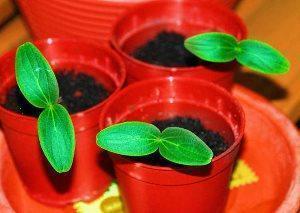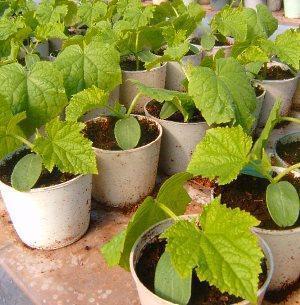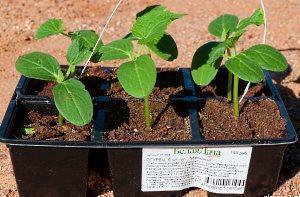How to grow good cucumber seedlings at home?
 Cucumbers are a popular pumpkin crop, an annual herb that is successfully grown both outdoors and in sheltered greenhouses. Cucumbers have been successfully cultivated by mankind for over 6 thousand years, they come from the foothills of the Himalayas and are even mentioned in the Bible. Despite its ancient origin, cucumber is still included in numerous national cuisines and is successfully used to prepare many delicious and healthy dishes.
Cucumbers are a popular pumpkin crop, an annual herb that is successfully grown both outdoors and in sheltered greenhouses. Cucumbers have been successfully cultivated by mankind for over 6 thousand years, they come from the foothills of the Himalayas and are even mentioned in the Bible. Despite its ancient origin, cucumber is still included in numerous national cuisines and is successfully used to prepare many delicious and healthy dishes.
Due to the dietary properties of this vegetable, it has many fans all over the world: it practically does not contain proteins, carbohydrates and fats, but it contains a lot of potassium, which is indispensable for the health of the heart and kidneys, vitamins, including carotene, as well as a high percentage of trace elements ... Since ancient times, cucumber has been used both as a medicinal plant and in cosmetics.
Features of growing cucumber seedlings
In order to properly grow cucumber seedlings at home, you must follow a number of rules:
- Soil selection.
- The timing of planting cucumbers for seedlings.
- Light mode.
- Temperature conditions.
- Planting cucumber seedlings in a greenhouse.

To grow cucumber seedlings for a greenhouse, it is necessary to select the so-called parthenocarpic, or self-pollinated varieties that do not need the help of bees and other insects. If the seedlings are intended for open ground, bee-pollinated varieties of this vegetable are also suitable.
Seeds offered for sale come in different qualities - regular, processed and granulated.
- Before planting, ordinary seeds must be calibrated and rejected: knowingly crippled and small ones are immediately selected, and the remaining ones are immersed in a strong solution of table salt - the floating seeds are unusable, and full-fledged ones will go to the bottom. They are chosen, washed thoroughly with fresh water and dried or immediately processed for sowing.
- Treated seeds are prepared for planting, they are often recommended to be sown directly into open ground, as they are covered with the thinnest layer of antifungal and antimicrobial agents. Granulated seeds, in addition to protective ones, are also covered with a layer of nutrients that give a positive start to young immature plants.
- Calibrated seeds need moisture and warmth to germinate. If these two conditions are not ensured, even seeds that have already hatched may die. Most often they are wrapped in a damp cloth and placed in a place with a high temperature (about 30 degrees). Seeds that have formed a small root must be planted immediately in the ground.
An important question for getting good cucumber seedlings at home is when to plant cucumbers for seedlings.
If done too early, the seedlings will outgrow, stretch out, and be pale and fragile. Such seedlings are unlikely to make a strong and healthy actively bearing plant.
If you delay planting cucumbers for seedlings, the plants will be too small and weak, it will take a long time to take root in the ground and the harvest will be late.
The optimal time for planting cucumber seeds for seedlings is 20-25 days before the planned date of transplantation into the ground or greenhouse.
The choice of soil for cucumber seedlings
 For active growth and high-quality fruiting, it is advisable to plant cucumber seeds for seedlings in the ground, chemical and mechanical composition similar to the one in which the plant will continue to live. In this case, it will be easier for the roots of a young cucumber to germinate in a new environment and gain a foothold in it.
For active growth and high-quality fruiting, it is advisable to plant cucumber seeds for seedlings in the ground, chemical and mechanical composition similar to the one in which the plant will continue to live. In this case, it will be easier for the roots of a young cucumber to germinate in a new environment and gain a foothold in it.
As soon as the first cotyledon leaves appear, the cucumber seedlings must be placed in a cooler and brighter place. This is necessary so that the section of the stem under the cotyledons does not stretch out, forming weak, fragile seedlings. You need a lot of light, but direct sunlight should be avoided - they can burn delicate and soft young leaves. Water the seedlings with warm water, spray only in the first half of the day in not sunny weather or in a place protected from direct sunlight.
Cucumbers love humid air, but do not tolerate "leaving" at night with wet leaves - in such a situation, the plants quickly attack fungal diseases.
Temperature disorders such as excessive heat and prolonged hypothermia of seedlings, especially in combination with high air and soil humidity, lead to black leg disease. With this form of root rot, a black area appears at the base of the plant stem, near the ground itself, causing cell death and the death of the entire green part. It will not be possible to save the affected plant, it must be urgently removed and destroyed along with the earth - it is the source of the disease. The remaining seedlings must be treated with fungicides.
The optimal soil composition for cucumber seedlings:
- Sod or humus land.
- Peat.
- Sand.
- Drainage (added to the bottom of the planting container to remove excess moisture). Expanded clay, vermiculite, sunflower husks and other adsorbent materials can be used as drainage.
Correct planting of seeds
 Prepared or processed seeds must be planted in individual containers, since the cucumber does not tolerate root damage during transplantation. Such seedlings take root for a long time, get sick and may die. Even an established plant will be much less productive than one grown in a glass and planted with a whole lump of earth.
Prepared or processed seeds must be planted in individual containers, since the cucumber does not tolerate root damage during transplantation. Such seedlings take root for a long time, get sick and may die. Even an established plant will be much less productive than one grown in a glass and planted with a whole lump of earth.
It is necessary to plant cucumbers for seedlings with 2 seeds per planting container in order to guarantee the required number of plants. After pecking the seeds and unfolding the cotyledonous leaves, the weaker plant must be removed, otherwise both cucumber seedlings will be weakened due to competition for water, light and nutrients. It is impossible to pull out or pull out the plant - it can pull along the still weak roots of the remaining seedling and damage them. The easiest way is to gently pinch off or cut it off at ground level, the rest will gradually decompose without harm to the second plant. Now the seedling will be spacious and will get a lot of nutrients.
What if the cucumber seedlings are stretched out?
Prolonged pale seedlings are a common occurrence when grown at home. To prevent this from happening, you need to change two modes of growing cucumber seedlings - temperature and light.
The air temperature must be reduced to about 15 degrees, and the seedlings must be additionally illuminated, if there is very little light, this will have to be done around the clock.
On bright windows, it is enough to install side and top mirrors, which will reflect sunlight onto the seedlings. Sometimes it is enough to arrange cucumbers with cucumbers away from each other, especially if they already have large enough leaves that shade each other.
If the seedlings are very elongated, they can be helped when planting in the ground. Such a plant is carefully and carefully buried to the cotyledons or gradually sprinkled with warm and loose earth.The main condition for good survival of elongated seedlings is to plant them in well-heated, not waterlogged soil.
If it had to be planted in cold ground, the ground around such a plant is covered with a dark perforated film, which accumulates solar heat and evaporates excess moisture. In this case, the part of the stem buried in the ground will not rot, but will give additional roots and support the weak elongated seedlings. After a while, it will be the same strong and green plant as everyone else.
Seedlings of cucumbers begin to bloom very quickly, even in the cups the first buds are already forming. This does not negatively affect the quality of strong healthy seedlings, but from a weakened one it can take away already small strength.
 For such seedlings, it will be better to remove the first flowers and give the plant the opportunity to take root well in the ground, improve its health and form a strong bush.
For such seedlings, it will be better to remove the first flowers and give the plant the opportunity to take root well in the ground, improve its health and form a strong bush.
This plant will begin to bear fruit a little later than the others, but will quickly make up for lost time and be equal in yield to the rest of the seedlings. A weak or elongated seedling planted with buds or flowers will be sore for a long time, can shed buds and even ovaries, and as a result, it will give much less fruit.
Seedlings of cucumbers planted in open ground or in a greenhouse are much more demanding on air humidity than other crops, but they do not tolerate at all if at least a drop of water remains on the leaves at night. In this case, the seedlings quickly become ill with powdery mildew, from which the whole plantation or the "population" of the greenhouse can die.
Therefore, cucumbers are watered in the morning with warm water, trying not to leave the leaves wet until the evening. If necessary, the plants are sprayed, but so that they have time to dry out by night.
Cucumbers are one of the most grateful garden crops, which, with minimal care and attention, will thank their owners with an abundant and tasty harvest.
Read about growing cucumbers in a greenhouse in our next article.
Thank you, good article and great video
this year I started seedlings, but, apparently, the first pancake is lumpy ... the cucumbers are stretched out and when real leaves appear, we are already 12 cm, is it bad or can the seedlings be saved?
You will save if you transplant (along with a clod of earth) with a high capacity and cover it with earth until the cotyledon leaves
Please tell me! I will plant for the first time, cucumbers are already blooming right in the box on the windowsill, the garden is not ready yet, what should I do? after a neat transplant, they won't have anything? can what to feed the earth that would take root well ?!
When transplanting, the main thing is not to damage the root system. Your neatness is needed here. There is no point in fertilizing the garden now; this must be done at least a week before transplanting. But making root liquid top dressing is simply necessary. Use when transplanting Bikes EM-1 for watering the plant in a new place. Spraying with an iodine solution with the addition of milk works well on the leaves. For 1 liter of water 1-2 drops of iodine and 50 g of milk.